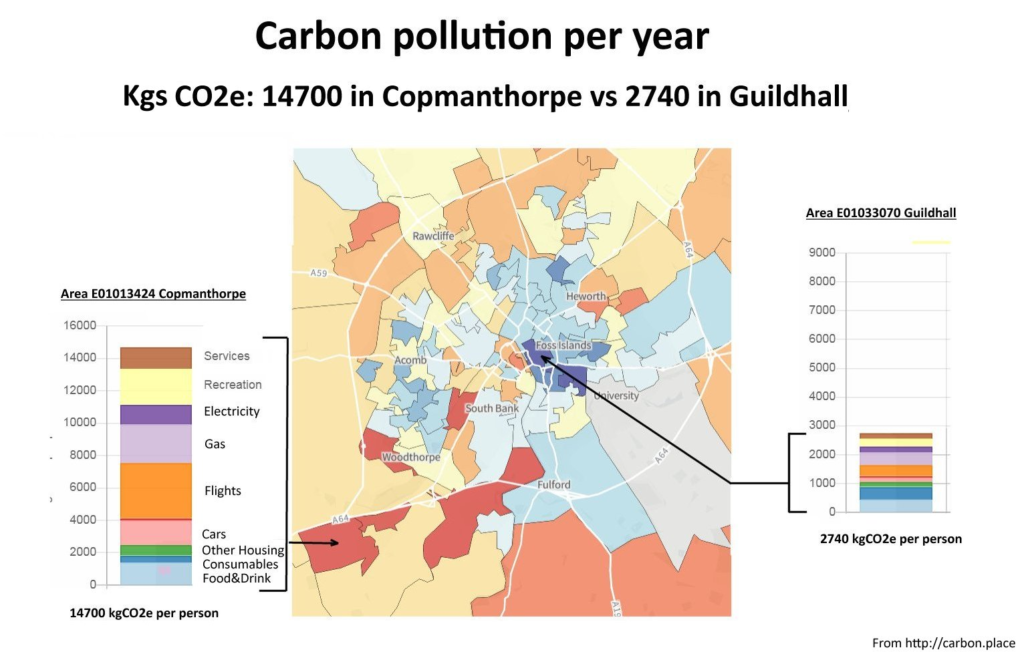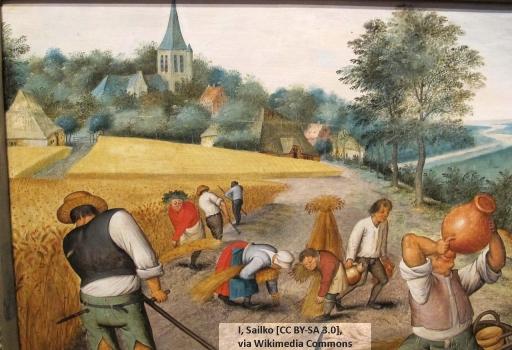Cutting carbon without cutting jobs

Flying is one of the most carbon intensive activities:
More CO2 emitted for every pound spent.
Carbon intensity
As noted in the previous post, Green Growth or Degrowth, carbon intensity is a measure of the amount of CO2 emitted (in grams CO2) for each unit of economic output (e.g. in £). Worldwide it’s presently over 500 grams CO2 for every £ of economic output produced.
Activities with high carbon intensities
For 50 years or more carbon intensity has declined: For a given amount of economic output (Gross Domestic Product or GDP) there has been less CO2 emitted. This has been a steady downward trend. Doubling the rate of decline only allows a very small increase in GDP – if emissions are to keep within carbon budgets.
Degrowth, a fall in GDP, would also be difficult if applied uniformly across the economy. However, individual aspects of the economy have different carbon intensities: A sensible strategy would aim cuts at those activities with the highest intensities, where small amounts of expenditure cause high carbon emissions. A high tax on carbon emissions would achieve this, especially if revenue were spent on schemes to avoid emissions further.
Essentiality
Of course, different cuts in economic activity have different consequences for everyday life: Cutting a family’s food budget by 50% has greater impact than cutting expenditure on computer games.
Good strategies should cut consumption of less essential, high intensity goods and services. However, measures of essentiality are not easily found.
The UK Office of National Statistics publishes estimates of CO2 emissions intensity. These show some of the most carbon intensive parts of UK GDP.
Electricity and Gas
Although their intensity has fallen dramatically since 1990, electricity and gas are still over 15 times the average carbon intensity of UK GDP.
Reducing the carbon emissions of electricity and gas can be done by improving the carbon intensity of generation per kilowatt-hour, for example by encouraging electricity generation from renewable sources. They can also be cut by reducing demand by insulating homes.
Transport
UK transport has an average carbon intensity five times the average. Within transport, flying is one of the most carbon intensive activities for every pound spent.
Aviation is not presented separately in the ONS figures but an economy, return flight Leeds to Malaga costs £63, as Ryanair are currently offering. Emissions are 406 Kgs CO2 giving a carbon intensity of over 400 times the average UK intensity for all economic activity, given by the ONS.
Reducing flying by taxing aviation would reduce carbon emissions by reducing UK GDP. It would also improve the average emissions intensity by reducing one of the most carbon intensive activities. This may be politically difficult but not as difficult as substantially reducing the use of private cars, which in total have a much bigger impact than aviation: Although each individual journey by car causes much less emissions that an air flight, there are many more car journeys.
UK agriculture
UK agriculture has a carbon intensity four times the UK average emissions intensity. For the cultivation of grains like wheat, oats or barley a substantial carbon emission are from the production of fertiliser. but the biggest source of emissions comes for animal agriculture.
In a meal of beef steak and chips, the beef can have a carbon footprint 100s of times greater than the chips.
Changes in diet will be necessary to save the climate. e.g. Eat more low carbon soft wheat by eating more cake and pasta and less bread, which uses high carbon hard wheat.
The falling value of labour
In 1978, I wrote Reducing the cost of labour to create full employment. This argued that microprocessor technology would cause a slump in the value of labour and that “the present phase of technological change is likely to bring a fall in the real value of labour, just as happened in the first industrial revolution.”
In the 1980s, it happened as I predicted. The Economist Magazine wrote:
“The ‘labour share’ of national income has been falling across much of the world since the 1980s. The Organisation for Economic Co-operation and Development (OECD), a club of mostly rich countries, reckons that labour captured just 62% of all income in the 2000s, down from over 66% in the early 1990s.”
Even if the robot job apocalypse, is more muted than the hype, it looks as if artificial intelligence will have further influence on reducing labour’s share of value. Leading to my conclusion that:
“technological change can bring about conditions under which a large proportion of the: population cannot live by the sale of their labour alone, and they should not be expected to do so.”
This conclusion can be rejected if economic growth is high enough: Labour’s share of output may be reduced but as output is higher, the lower paid can still have a decent living. This is the hope for advocates of Green Growth, but this demands that a sharp reduction in the carbon intensity of GDP to avoid increased carbon emissions.
In the real world this is unlikely to happen: The climate must be protected by restricting – even shrinking – GDP. In this case low paid workers must receive unearned income if their their standard of living is to be protected from a disastrous fall.
Redistributing the rewards of capital
Economists often divide the factors of production into two parts, labour and capital. As the share of labour decreases, the share of capital must increase. To support the standards of living of the low paid, means awarding them some of the increasing rewards of capital. Since the rich and affluent currently receive most of the income from capital, this is a redistribution from rich to poor.
The political advantage of Green Growth proposals is that they avoid the redistribution issue: It is not necessary to take from the rich to support the poor if economic growth is high enough. However, green growth for a whole economy is unlikely. Some selected activities may be found that increase GDP without increasing emissions, but these will be minor exceptions.
There are many ways of taxing capital to support the income of the lower paid. I proposed a solution by labour subsidy in the 1970s. It was designed to hide the fact of redistribution: It raised the nominal rate of VAT (which everyone pays) and gave a rebate for every worker a business employs. The actual total VAT taken could actually be less because, as a job creation scheme, is saved on benefits.
Doing the calculations, it’s effect would be to increase the tax paid by the high-spending rich and affluent and lower the cost of employing lower paid labour. (See: A macroprudential proposal for employment.)
There are many other means of cutting the cost of labour to reflect its decreasing importance in production. Some schemes would use benefits which are not related to work like Universal Basic Income. This would support the income of everybody and so allow lower wages without low incomes. Some schemes, like mine, directly lower the cost of employing labour.
Some schemes propose directly taxing carbon emissions, such as the Fee and Dividend scheme, supported by the prominent climate Scientist, James Hansen.
Why should the rich and affluent pay?
This is a moral question, which economists often try to avoid. Answers:
- It is right in principle – according to utilitarian economists.
- The affluent are the main polluters and polluters should pay.
Some basics facts are well known. Oxfam’s infographic illustrates the situation: The richest 10% of the world cause half the CO2 emissions. The poorest 50% of the world cause 10% of carbon emissions.

This is also true at a local scale. The carbon.place website shows estimates of carbon emissions per person for small census areas in England. For example, the average emissions of residents in Copmanthorpe, an affluent suburb on the edge of York, are estimated to have carbon emissions over five times the emissions of some poorer areas with the city walls.

What jobs would be created if labour were cheaper?
“What jobs?” is a topic for future posts – but they won’t come from flying more planes.
Market economists would leave job creation for the market to determine. Others might wish to bend market forces to create pleasanter jobs. This could be part of designing different ways of living that do not destroy the climate.
Just like the old days?

TrackBack URL :
